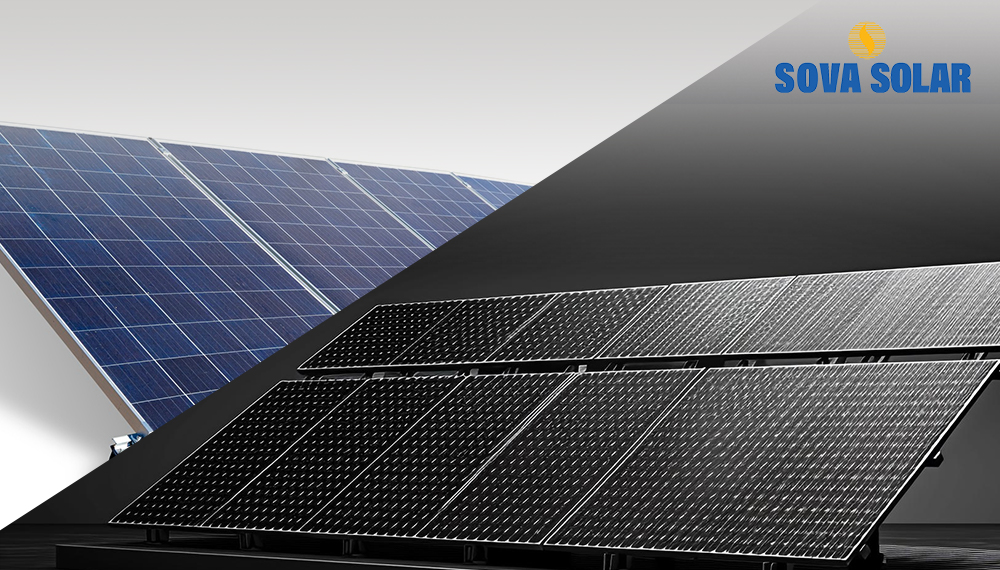
- sovasolar_admin
- Jul 2, 2025
- Uncategorized
- 0 Comments
Solar energy is no longer just a buzzword—it’s now a big part of how industries reduce energy costs and become more sustainable. But as solar technology grows, so do the options. One question many industrial owners now face is: “Should I go for TOPCon panels or stick with conventional ones like polycrystalline or monocrystalline?”
If you’ve heard the term TOPCon and wondered what it actually means—or whether it’s worth the investment—this article is for you.
Let’s explore how TOPCon compares with traditional panels, and help you figure out which one fits your facility’s needs best.
First Things First: What Are Solar Panels Made Of?
Before diving into comparisons, it helps to understand the basics.
Most solar panels used today are made of silicon, a natural material that converts sunlight into electricity. These panels fall into three main categories:
- Polycrystalline (multi-crystal panels): Common and cost-effective
- Monocrystalline (single crystal): Higher efficiency, better performance
- TOPCon (Tunnel Oxide Passivated Contact): An advanced form of monocrystalline with added efficiency and durability
All three types can power industrial operations—but the difference lies in how much energy they produce, how they perform under harsh conditions, and how quickly they pay back the investment.
What Is TOPCon Technology?
TOPCon stands for Tunnel Oxide Passivated Contact. It’s a newer technology that builds on monocrystalline panels by adding an ultra-thin tunnel oxide layer and a passivated contact structure at the back of the cell. That might sound complex—but here’s what it means in simple terms:
- More sunlight gets converted into electricity
- Less power is lost due to heat or resistance
- Panels perform better even in less-than-ideal conditions
This technology is especially useful for industrial units that need consistent, high-output power throughout the year.
Comparing TOPCon and Conventional Panels
Here’s how they stack up in key areas:
| Feature | TOPCon Panels | Conventional Panels (Mono/Poly) |
| Efficiency | Higher (22–24%) | Moderate (17–21%) |
| Temperature Resistance | Better performance in heat | Can lose efficiency in high temps |
| Lifespan & Stability | Long-lasting, slow degradation | Good, but may degrade slightly faster |
| Installation Area | Requires less space for same output | May need more panels for same output |
| Cost | Higher upfront | More affordable initially |
| Best Use Case | High-demand industrial facilities | General use, medium-scale applications |
Why Efficiency Matters for Industries
Industrial operations usually run heavy machinery, cooling systems, and lighting, all of which consume a lot of power. A more efficient panel like TOPCon means:
- Fewer panels needed on the rooftop
- More power per square foot
- Faster return on investment (ROI)
And in locations with extreme heat, such as parts of Rajasthan or central India, TOPCon panels can outperform conventional panels by producing more stable power throughout the day.
When Conventional Panels Still Make Sense
While TOPCon has clear advantages, it’s not always the automatic choice. Many industries still choose polycrystalline or standard monocrystalline panels because:
- They have a lower entry cost, which is great for budget-conscious projects
- They are proven, reliable, and widely available
- They meet the needs of small to mid-sized operations
For example, Sova Solar’s polycrystalline modules are manufactured under strict ISO standards and certified by IEC, CE, and UL. These panels are known for durability—even in dusty, hot, and humid Indian climates.
So, if your energy usage is steady but not extremely high, or if you want a safe and cost-effective entry into solar, conventional panels are still a smart and practical choice.
What to Consider Before You Decide
Choosing between TOPCon and conventional panels depends on a few key factors:
- Available Roof Space
If space is limited, high-efficiency panels like TOPCon help you make the most of every square foot. - Energy Consumption Patterns
Industries with heavy, round-the-clock energy use may benefit more from TOPCon due to higher output. - Budget and ROI Timeline
Conventional panels have a lower upfront cost, but TOPCon may offer better long-term savings. - Location and Climate
For hot, sunny, and dusty conditions, durability is crucial. Sova Solar designs panels tested to perform under Indian weather extremes.
Sova Solar’s Approach
At Sova Solar, the focus is on helping industries make informed solar choices. Whether you’re installing a rooftop plant in Kolkata or powering operations in Madhya Pradesh, the panels are built to deliver reliable output and long-term value.
Every product is:
- MNRE “A” rated
- Backed by ISO 9001 and 14001 standards
- Tested for performance under desert and high-temperature conditions
And with both polycrystalline and Mono-PERC (monocrystalline) panels in its lineup, Sova Solar helps industries pick the right solution—without upselling or over-promising.
Even if TOPCon isn’t listed directly, the company’s emphasis on advanced, high-efficiency modules (like bifacial Mono-PERC) shows a clear alignment with the next-gen solar shift.
Final Thoughts
Choosing the right type of solar panel isn’t just about tech specs—it’s about what works best for your facility, your goals, and your budget.
- Go for TOPCon if you want top-tier performance, limited space usage, and faster ROI.
- Stick with conventional panels if you want reliable performance, easier budgeting, and proven long-term use.
No matter which one you choose, moving to solar is a decision that pays off in more ways than one—from lowering your bills to strengthening your sustainability goals.
And with an experienced partner like Sova Solar, your journey from rooftop to energy independence is in capable hands.






